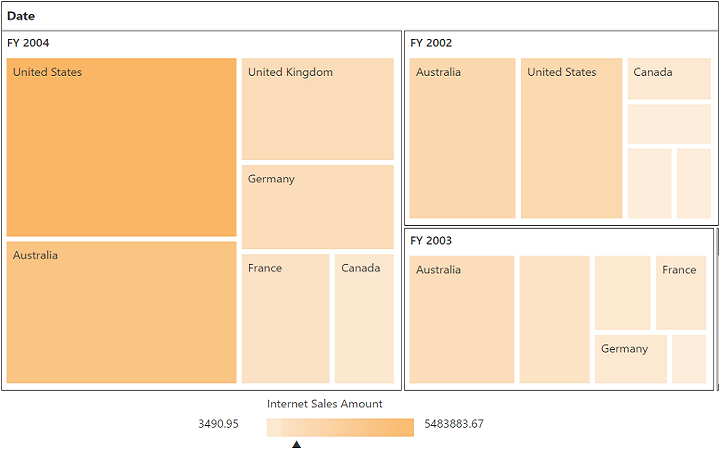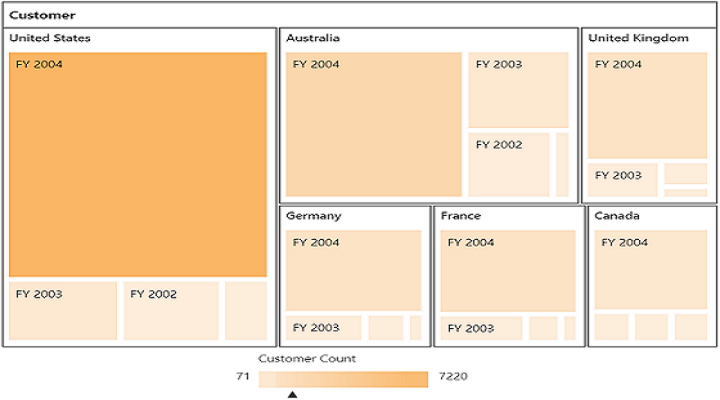- Creating a simple application with pivot tree map and OLAP data source (client mode)
- Creating a simple application with pivot tree map and OLAP data source (server mode)
Contact Support
Getting started with JavaScript PivotTreeMap
3 May 202124 minutes to read
Creating a simple application with pivot tree map and OLAP data source (client mode)
This section covers the information required to populate a simple pivot tree map with the OLAP data completely on the client-side.
Scripts and CSS references
Create an HTML page and add scripts and style sheets that are required to render a pivot tree map widget which are highlighted below in an appropriate order:
- ej.web.all.min.css
- jQuery-3.0.0.min.js
- ej.web.all.min.js
- jsrender.min.js
Initialize pivot tree map
Place a “div” tag in the HTML page which acts as a container for the pivot tree map widget. Then, initialize the widget by using the “ejPivotTreeMap” method.
<!DOCTYPE html>
<html>
<head>
<title>PivotTreeMap - Getting Started</title>
<link href="http://cdn.syncfusion.com/28.1.33/js/web/flat-azure/ej.web.all.min.css" rel="stylesheet" type="text/css" />
<script src="http://cdn.syncfusion.com/js/assets/external/jquery-3.0.0.min.js" type="text/javascript"></script>
<script src="http://cdn.syncfusion.com/28.1.33/js/web/ej.web.all.min.js" type="text/javascript"></script>
<script src="http://cdn.syncfusion.com/js/assets/external/jsrender.min.js" type="text/javascript"></script>
</head>
<body>
<! --Create a tag which acts as a container for ejPivotTreeMap widget. -->
<div id="PivotTreeMap1" style="min-height: 275px; min-width: 525px; height: 460px; width: 99%;"> </div>
<script type="text/javascript">
$(function () {
//Set properties and initialize ejPivotTreeMap widget.
$("#PivotTreeMap1").ejPivotTreeMap();
});
</script>
</body>
</html>Populate pivot tree map with data source
Initialize the OLAP data source for the pivot tree map widget as shown below:
<html>
//……
<body>
<div id="PivotTreeMap1" style=" min-height: 275px; min-width: 525px; height: 460px; width: 99%;"> </div>
<script type="text/javascript">
$(function() {
$("#PivotTreeMap1").ejPivotTreeMap({
dataSource: {
data: "http://bi.syncfusion.com/olap/msmdpump.dll",
catalog: "Adventure Works DW 2008 SE",
cube: "Adventure Works",
rows: [{
fieldName: "[Customer].[Customer Geography]"
}],
columns: [{
fieldName: "[Date].[Fiscal]"
}],
values: [{
measures: [{
fieldName: "[Measures].[Customer Count]",
}],
axis: "columns"
}]
}
});
});
</script>
<!--Tooltip labels can be localized here-->
<script id="tooltipTemplate" type="application/jsrender">
<div style="background:White; color:black; font-size:12px; font-weight:normal; border: 1px solid #4D4D4D; white-space: nowrap;border-radius: 2px; margin-right: 25px; min-width: 110px;padding-right: 5px; padding-left: 5px; padding-bottom: 2px ;width: auto; height: auto;">
<div>Measure(s) : </div><div>Row : </div><div>Column : </div><div>Value : </div>
</div>
</script>
</body>
</html>The above code will generate a simple pivot tree map showing customer count over different customer geographic locations across a period of fiscal years.

The following table will explain the OLAP dataSource properties at client-side in detail:
| Properties | Description | ||||||||||||
|---|---|---|---|---|---|---|---|---|---|---|---|---|---|
| Contains the respective cube name from OLAP database as string type. | |||||||||||||
| To set the data source name to fetch data from that. | |||||||||||||
| Sets the provider name for PivotTreeMap to identify whether the provider is SSAS or Mondrian. | |||||||||||||
| Provides the raw data source for the PivotTreeMap. | |||||||||||||
| In connection with an OLAP database, this property contains the database name as string to fetch the data from the given connection string. | |||||||||||||
Lists out the items to be displayed as series of PivotTreeMap.
|
|||||||||||||
Lists out the items to be displayed as segments of PivotTreeMap.
|
|||||||||||||
Lists out the items which supports filtering of values without displaying the members in UI in PivotTreeMap.
|
|||||||||||||
Lists out the items supports calculation in PivotTreeMap.
|
Creating a simple application with pivot tree map and OLAP data source (server mode)
This section covers the information required to create a simple pivot tree map bound to the OLAP data source.
NOTE
This section is illustrated by creating a simple web application through the Visual Studio IDE, since the pivot tree map can also act as a
server-sidecontrol with .NET dependency. The web application contains an HTML page and a service that will transfer the data toserver-side, process it, and return it toclient-sidefor control re-rendering. The service utilized for communication can be either the WCF or WebAPI based on user requirement. Here, both are illustrated for user convenience.
Project initialization
Create a new ASP.NET Empty Web Application by using the Visual Studio IDE and name the project “PivotTreeMapDemo.”
Next, you can add an HTML page. To add an HTML page in your web application, right-click the project in the solution explorer and select Add > New Item. In the Add New Item window, select HTML Page and name it “GettingStarted.html,” and then click Add.
Now, you can set the “GettingStarted.html” page as start-up page. To do so, right-click the “GettingStarted.html” page and select “Set As Start Page”.
Scripts and CSS initialization
The scripts and style sheets that are required to render a pivot tree map widget in the HTML page are highlighted below in an appropriate order:
- ej.web.all.min.css
- jQuery-3.0.0.min.js
- ej.web.all.min.js
- jsrender.min.js
The scripts and style sheets listed above can be found in any of the following locations:
Local disk: Click here to know more about script and style sheets installed on the local machine.
CDN link: Click here to know more about script and style sheets available in online.
NuGet package: Click here to know more about script and style sheets available in the NuGet package.
Control initialization
To initialize a pivot tree map widget, first you can define a “div” tag with an appropriate “id” attribute which acts as a container for the pivot tree map widget. Then, you can initialize the widget by using ejPivotTreeMap method.
<!DOCTYPE html>
<html xmlns="http://www.w3.org/1999/xhtml">
<head>
<title>PivotTreeMap - Getting Started</title>
<link href="http://cdn.syncfusion.com/28.1.33/js/web/flat-azure/ej.web.all.min.css" rel="stylesheet" type="text/css" />
<script src="http://cdn.syncfusion.com/js/assets/external/jquery-3.0.0.min.js" type="text/javascript"></script>
<script src="http://cdn.syncfusion.com/28.1.33/js/web/ej.web.all.min.js" type="text/javascript"></script>
<script src="http://cdn.syncfusion.com/js/assets/external/jsrender.min.js" type="text/javascript"></script>
</head>
<body>
<form id="form1" runat="server">
<div>
<! --Create a tag which acts as a container for ejPivotTreeMap widget. -->
<div id="PivotTreeMap1" style="min-height: 275px; min-width: 525px; height: 460px; width: 99%;"> </div>
<script type="text/javascript">
//Set properties and initialize ejPivotTreeMap widget.
$(function ()
{
$("#PivotTreeMap1").ejPivotTreeMap(
{
url: "/Olap"
});
});
</script>
<!--Tooltip labels can be localized here-->
<script id="tooltipTemplate" type="application/jsrender">
<div style="background:White; color:black; font-size:12px; font-weight:normal; border: 1px solid #4D4D4D; white-space: nowrap;border-radius: 2px; margin-right: 25px; min-width: 110px;padding-right: 5px; padding-left: 5px; padding-bottom: 2px ;width: auto; height: auto;">
<div>Measure(s) : </div><div>Row : </div><div>Column : </div><div>Value : </div>
</div>
</script>
</div>
</form>
</body>
</html>The url property in the pivot tree map widget points the service endpoint, where the data is processed and fetched in the form of JSON. The service used for the pivot tree map widget as endpoint are WCF and WebAPI.
NOTE
The above “GettingStarted.html” contains WebAPI
url, which is “/Olap”. If you are using the WCF service then theurlwill look like “/OlapService.svc”.
Register the referenced assemblies in “Web.config” file available at the root of the application.
<compilation debug="true" targetFramework="4.5.1">
<assemblies>
……
……
<add assembly="Syncfusion.EJ, Version= 28.1450.33, Culture=neutral, PublicKeyToken=3d67ed1f87d44c89" />
<add assembly="Syncfusion.EJ.Pivot, Version= 28.1450.33, Culture=neutral, PublicKeyToken=3d67ed1f87d44c89" />
<add assembly="Syncfusion.EJ.Export, Version= 28.1450.33, Culture=neutral, PublicKeyToken=3d67ed1f87d44c89" />
<add assembly="Syncfusion.Linq.Base, Version= 28.1450.33, Culture=neutral, PublicKeyToken=3d67ed1f87d44c89" />
<add assembly="Syncfusion.Olap.Base, Version= 28.1450.33, Culture=neutral, PublicKeyToken=3d67ed1f87d44c89" />
<add assembly="Syncfusion.Compression.Base, Version= 28.1450.33, Culture=neutral, PublicKeyToken=3d67ed1f87d44c89" />
<add assembly="Syncfusion.PivotAnalysis.Base, Version= 28.1450.33, Culture=neutral, PublicKeyToken=3d67ed1f87d44c89" />
<add assembly="Syncfusion.Pdf.Base, Version= 28.1450.33, Culture=neutral, PublicKeyToken=3d67ed1f87d44c89" />
<add assembly="Syncfusion.XlsIO.Base, Version= 28.1450.33, Culture=neutral, PublicKeyToken=3d67ed1f87d44c89" />
<add assembly="Syncfusion.DocIO.Base, Version= 28.1450.33, Culture=neutral, PublicKeyToken=3d67ed1f87d44c89" />
</assemblies>
</compilation>WebAPI
Adding a WebAPI controller
To add a WebAPI controller in your existing web application, right-click the project in the solution explorer and select Add > New Item. In the Add New Item window, select WebAPI Controller Class and name it “OlapController.cs”, and then click Add.
The WebAPI controller is added to your application, which, in-turn, comprises the following file. The utilization of this file will be explained in the following sections:
- OlapController.cs
NOTE
While adding the WebAPI controller class, add the mandatory suffix “Controller”. For example, in the demo, the controller is named as “OlapController”.
Next, remove all the existing methods such as “Get”, “Post”, “Put”, and “Delete” present in the OlapController.cs file.
namespace PivotTreeMapDemo
{
public class OlapController : ApiController
{
}
}List of dependency libraries
Next, you can add the below mentioned dependency libraries to your web application. These libraries can be found in the GAC (Global Assembly Cache).
To add them to your web application, right-click References in the solution explorer and select Add Reference. In the Reference Manager dialog, under Assemblies > Extension, the following Syncfusion libraries are found.
NOTE
If you have installed any version of SQL Server Analysis Service (SSAS) or Microsoft ADOMD.NET utility, then the location of Microsoft.AnalysisServices.AdomdClient library is [system drive:\Program Files (x86)\Microsoft.NET\ADOMD.NET]. If you have installed any version of Essential Studio, then the location of Syncfusion libraries is [system drive:\Program Files (x86)\Syncfusion\Essential Studio\28.1.33\Assemblies].
- Microsoft.AnalysisServices.AdomdClient
- Syncfusion.Compression.Base
- Syncfusion.Linq.Base
- Syncfusion.Olap.Base
- Syncfusion.PivotAnalysis.Base
- Syncfusion.EJ
- Syncfusion.EJ.Export
- Syncfusion.EJ.Pivot
List of namespaces
Following are the list of namespaces to be added on top of the main class in the OlapController.cs file.
using System.Web;
using System.Collections.Generic;
using System.Configuration;
using System.Linq;
using System.Net;
using System.Net.Http;
using System.Web.Http;
using System.Web.Script.Serialization;
using Syncfusion.Olap.Manager;
using Syncfusion.Olap.Reports;
using Syncfusion.JavaScript;
using OLAPUTILS = Syncfusion.JavaScript.Olap;
namespace PivotTreeMapDemo
{
public class OlapController : ApiController
{
}
}Data source initialization
Now, the connection string to connect the OLAP cube and pivot tree map instances is created immediately in the main class of the OlapController.cs file.
namespace PivotTreeMapDemo
{
public class OlapController : ApiController
{
PivotTreeMap htmlHelper = new PivotTreeMap();
string connectionString = "Data Source=http://bi.syncfusion.com/olap/msmdpump.dll; Initial Catalog=Adventure Works DW 2008 SE;";
//Other codes
}
}Service methods in WebAPI controller
Now, you can define the service methods in the OlapController class, find in the OlapController.cs file which was created while adding the WebAPI controller class to your web application.
namespace PivotTreeMapDemo
{
public class OlapController : ApiController
{
PivotTreeMap htmlHelper = new PivotTreeMap();
string connectionString = "Data Source=http://bi.syncfusion.com/olap/msmdpump.dll; Initial Catalog=Adventure Works DW 2008 SE;";
[System.Web.Http.ActionName("InitializeTreeMap")]
[System.Web.Http.HttpPost]
public Dictionary<string, object> InitializeTreeMap(Dictionary<string, object> jsonResult)
{
OlapDataManager DataManager = null;
DataManager = new OlapDataManager(connectionString);
DataManager.SetCurrentReport(CreateOlapReport());
return htmlHelper.GetJsonData(jsonResult["action"].ToString(), DataManager);
}
[System.Web.Http.ActionName("DrillTreeMap")]
[System.Web.Http.HttpPost]
public Dictionary<string, object> DrillTreeMap(Dictionary<string, object> jsonResult)
{
OlapDataManager DataManager = new OlapDataManager(connectionString);
DataManager = new OlapDataManager(connectionString);
DataManager.SetCurrentReport(OLAPUTILS.Utils.DeserializeOlapReport(jsonResult["olapReport"].ToString()));
return htmlHelper.GetJsonData(jsonResult["action"].ToString(), DataManager, jsonResult["drillInfo"].ToString());
}
private OlapReport CreateOlapReport()
{
OlapReport olapReport = new OlapReport();
olapReport.Name = "Default Report";
olapReport.CurrentCubeName = "Adventure Works";
DimensionElement dimensionElementColumn = new DimensionElement();
//Specifying the Name for the Dimension Element
dimensionElementColumn.Name = "Date";
dimensionElementColumn.AddLevel("Fiscal", "Fiscal Year");
MeasureElements measureElementColumn = new MeasureElements();
//Specifying the Name for the Measure Element
measureElementColumn.Elements.Add(new MeasureElement { Name = "Customer Count" });
DimensionElement dimensionElementRow = new DimensionElement();
//Specifying the Dimension Name
dimensionElementRow.Name = "Customer";
dimensionElementRow.AddLevel("Customer Geography", "Country");
DimensionElement dimensionElementRow1 = new DimensionElement();
///Adding Row Members
olapReport.SeriesElements.Add(dimensionElementRow);
///Adding Column Members
olapReport.CategoricalElements.Add(dimensionElementColumn);
///Adding Measure Element
olapReport.CategoricalElements.Add(measureElementColumn);
return olapReport;
}
}
}Configure routing in global application class
To add a Global.asax in your existing web application, right-click the project in the solution explorer and select Add > New Item. In the Add New Item window, select Global Application Class and name it “Global.asax”, and then click Add.
After adding the Global.asax file, immediately add the namespace “using System.Web.Http;” and then configure the routing as shown in the following code example:
public class Global : System.Web.HttpApplication
{
protected void Application_Start(object sender, EventArgs e)
{
System.Web.Http.GlobalConfiguration.Configuration.Routes.MapHttpRoute(
name: "DefaultApi",
routeTemplate: "{controller}/{action}/{id}",
defaults: new { id = RouteParameter.Optional });
AppDomain.CurrentDomain.SetData("SQLServerCompactEditionUnderWebHosting", true);
}
}Now, the pivot tree map is rendered with customer count over different customer geographic locations across a period of fiscal years.

WCF
This section demonstrates the utilization of the WCF service as endpoint binding the OLAP data source to a simple pivot tree map. For more details on this topic, click here.